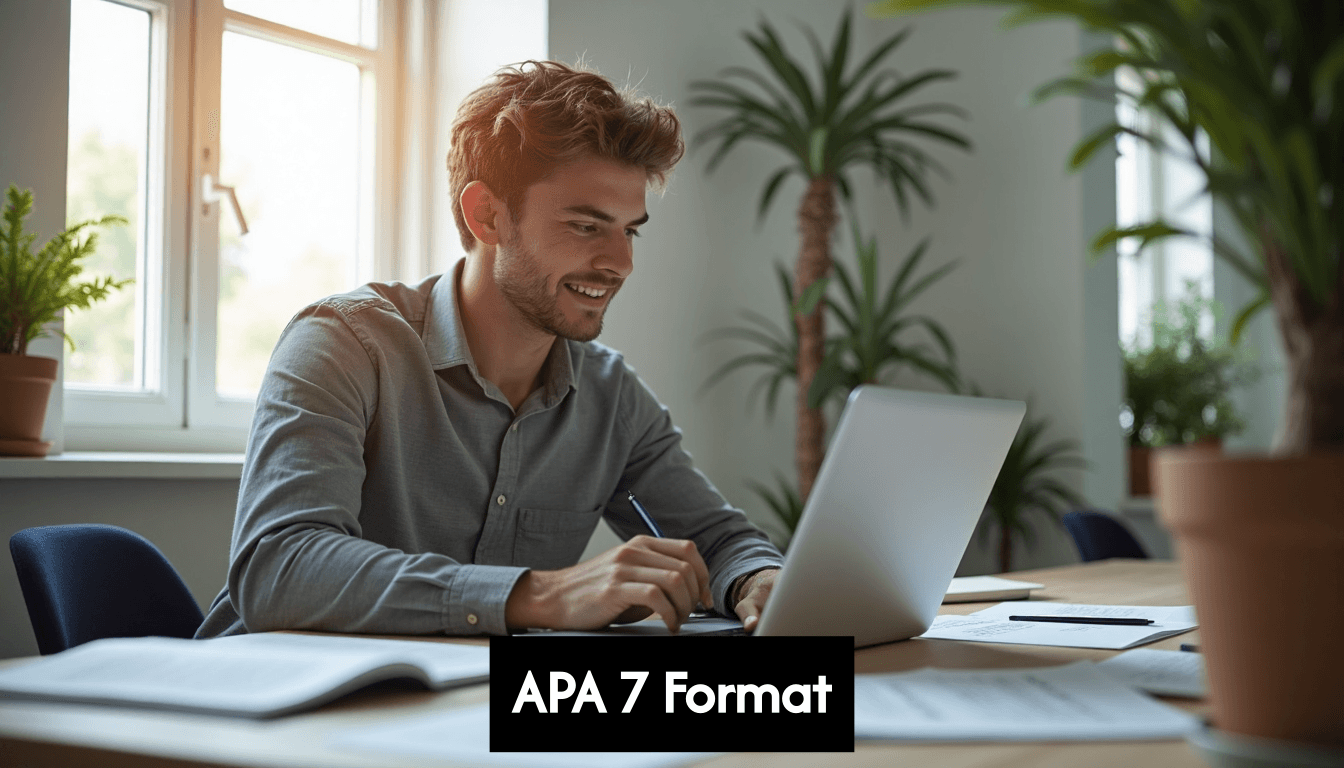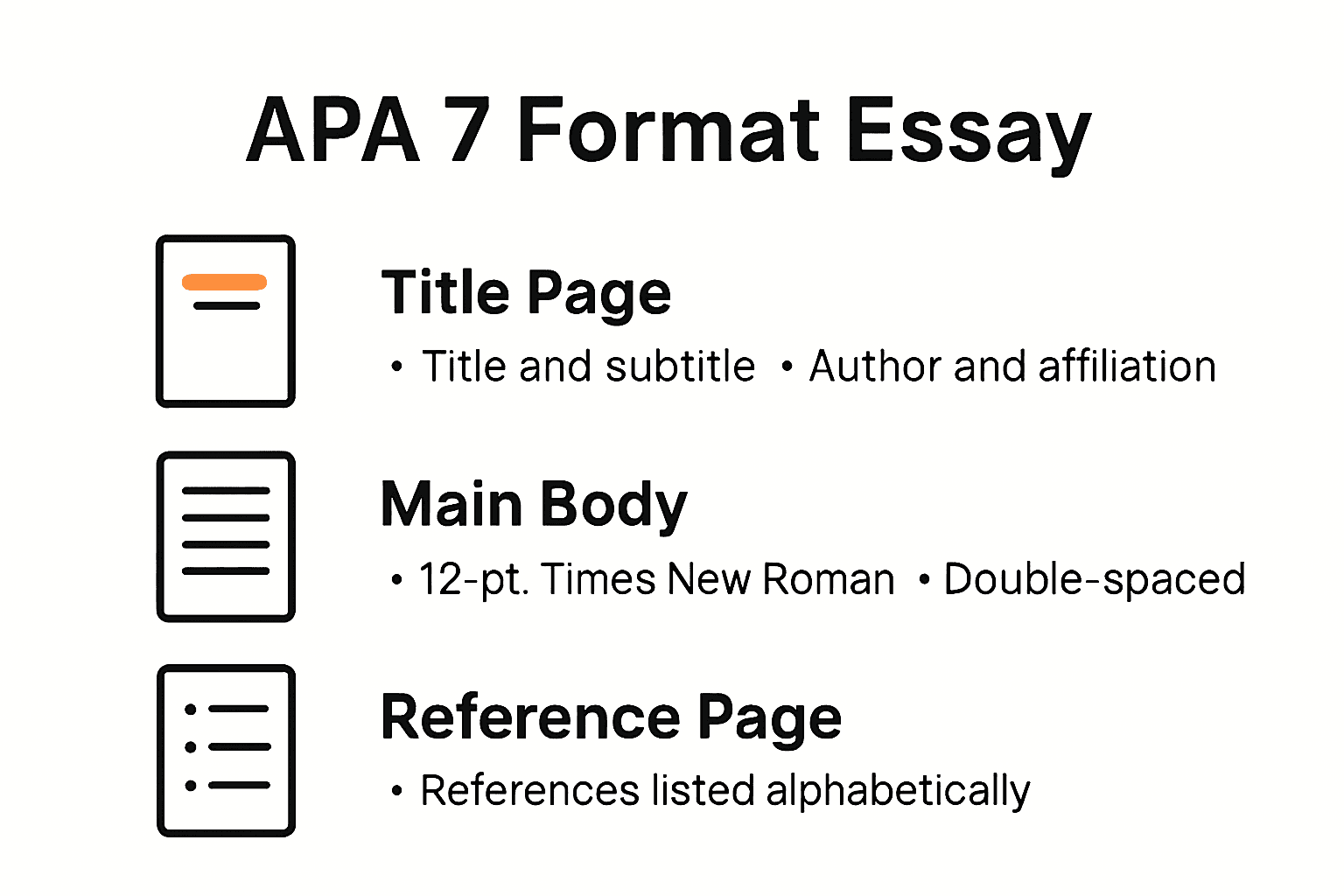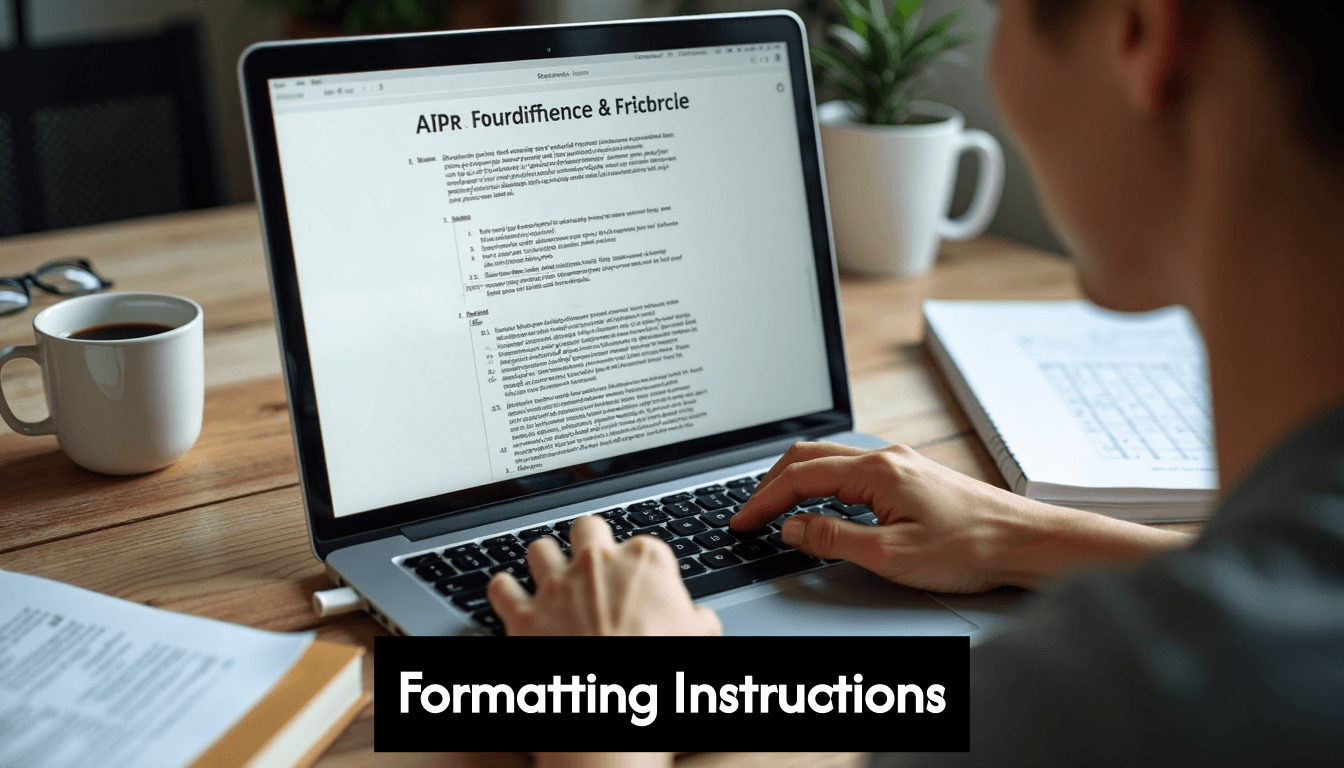Blog
Learning Materials
APA 7 Format Essay Guide 2025: Clear Steps for Students & Academics
Updated: June 11, 2025

APA 7 format is everywhere in academic writing, but most people still miss the details that matter. Here is the wild part nearly 60 percent of submitted student essays have incorrect in-text citations or missing reference details. You might think mastering font size or margins is the trickiest part. The reality is that the most overlooked mistakes happen in the way sources are cited and referenced, and this is exactly where grades are won or lost.
Table of Contents
- Formatting And Structural Errors
- Citation And Reference Challenges
- Academic Writing And Stylistic Pitfalls
Quick Summary
| Takeaway | Explanation |
|---|---|
| Title Page Requirements | Ensure your title page includes the paper's title, your full name, and institutional affiliation, with specific formatting for student and professional papers. |
| Citations and Reference Management | Master in-text citation techniques, including author, year, and page number for direct quotes, and learn to properly format your reference list with hanging indents and alphabetical order. |
| Common Formatting Errors | Be aware of frequent mistakes such as incorrect margins, inconsistent font usage, and citation mismatches between in-text citations and the reference list to avoid academic penalties. |
Essential Components of an APA 7 Format Essay
Creating a well-structured APA 7 format essay requires understanding its core components. Students and academics must pay careful attention to each element to ensure their academic writing meets professional standards. This section breaks down the critical sections that form a comprehensive APA 7 style document.
Title Page Requirements
The title page serves as the first impression of your academic work. According to our comprehensive guide on APA formatting, this page must include specific information in a precise layout. Your title page should contain the paper's full title centered on the page, using title case capitalization. Beneath the title, list your full name, followed by your institutional affiliation.
The page header differs for student and professional papers. For student papers, the only element on the header is the page number aligned to the right margin. Professional papers require additional information like running head and institutional affiliation. Page formatting is critical ensure professional presentation. The University of Lethbridge Library recommends using standard margins of 1 inch on all sides and selecting appropriate fonts like 12-point Times New Roman or 11-point Calibri.

Main Body and Formatting Standards
The main body of your APA 7 format essay demands consistent and precise formatting. Double-spacing is mandatory throughout the entire document, creating a clean and readable layout. Begin the main text on a new page after the title page, with the paper's title centered at the top of the first page.
Paragraph formatting requires a 0.5-inch indent for the first line of each paragraph. This indentation helps distinguish between paragraphs and creates a structured visual flow. When introducing sections within longer academic papers, use level headings to organize content. APA 7 provides specific guidelines for up to five levels of headings, each with distinct formatting to create a clear hierarchical structure.
Reference Page Essentials
The reference page represents the final critical component of an APA 7 format essay. This section demonstrates academic integrity by properly crediting sources. Begin the references on a separate page, with the word "References" centered at the top. Each source must follow specific formatting rules, including hanging indentation and a consistent alphabetical order.
Accurate citation is paramount in academic writing. According to APA 7 Citation Guidelines, different source types require unique citation formats. Whether you are referencing a book, journal article, or online source, precise attention to detail ensures academic credibility.
By mastering these essential components, students and researchers can create professional, polished academic documents that meet the rigorous standards of APA 7 format. Attention to detail in formatting, citation, and presentation transforms a simple essay into a scholarly work that demonstrates academic excellence.
Step-by-Step Essay Formatting Instructions
Navigating the precise requirements of APA 7 format can feel challenging, but breaking down the formatting process into clear steps makes it manageable for students and academics. This section provides a comprehensive walkthrough of formatting your academic essay with accuracy and professionalism.
Preparing Your Document Setup
Before you begin writing, establish the correct document foundation. Our comprehensive formatting guide recommends starting with the right technical specifications. Select a standard-sized document (8.5" x 11") and configure your page with 1-inch margins on all sides. Choose an approved font such as 12-point Times New Roman or 11-point Calibri, which ensures readability and meets APA 7 standards.
Double-spacing is mandatory throughout the entire document. This means every line of text, including references and block quotes, should have consistent spacing. Use the paragraph formatting tools in your word processor to set a 0.5-inch first-line indent for each new paragraph. This creates a clean, professional appearance that aligns with academic writing expectations.
Structuring Your Paper Elements
Paper structure in APA 7 follows a specific sequence. Start with the title page, which should be clean and informative. Center your paper's title using title case capitalization. Place your name and institutional affiliation beneath the title. For student papers, include the course information and submission date.
The page header requires careful attention. Student papers need only the page number aligned to the right margin. Professional or publication-bound papers have additional header requirements. Ensure each page is consecutively numbered, starting from the title page. This systematic approach demonstrates attention to detail and adherence to academic formatting standards.
Citations and Reference Management

Accurate citation is the cornerstone of academic writing. According to the APA 7 Citation Guidelines, in-text citations must include the author's last name and the publication year. When directly quoting sources, include the page number alongside the author and year. Parenthetical citations should be placed before the punctuation mark in most cases.
The reference page demands meticulous organization. Begin your reference list on a new page, with the word "References" centered at the top. Use a hanging indent for each reference entry, which means the first line is flush left, and subsequent lines are indented 0.5 inches. Organize sources alphabetically by the author's last name. Different source types (books, journal articles, websites) have specific formatting requirements, so consult the latest APA guidelines for precise details.
Mastering these step-by-step formatting instructions transforms a basic document into a professionally structured academic essay. Attention to detail in spacing, font, citations, and overall layout demonstrates scholarly precision and respect for academic communication standards.
Citing Sources and Building Your Reference List
Citing sources accurately is a critical skill in academic writing that demonstrates scholarly integrity and intellectual honesty. APA 7 format provides comprehensive guidelines for acknowledging the work of other researchers while giving proper credit to original sources. This section will explore the nuanced approach to creating precise citations and constructing a comprehensive reference list.
In-Text Citation Techniques
In-text citations form the backbone of academic attribution. Learn the fundamentals of research citations to ensure your academic writing meets professional standards. For direct quotes, include the author's last name, publication year, and specific page number. For example, (Smith, 2022, p. 45) demonstrates the correct format for a direct quotation.
Parentheticals can be placed in two primary formats. The narrative citation integrates the author's name into the sentence, while the parenthetical citation places the full reference information in parentheses. When citing multiple sources in a single parenthetical, arrange them alphabetically by the first author's last name, separated by semicolons. For sources with multiple authors, different rules apply based on the number of contributors.
Reference List Construction
The reference list represents the comprehensive documentation of sources used in your academic work. Begin the list on a new page, with the word "References" centered at the top of the page. Each entry requires a hanging indent, where the first line is flush left and subsequent lines are indented 0.5 inches. Organize sources alphabetically by the author's last name.
Different source types demand specific formatting. According to the APA 7 Citation Guidelines, a book citation includes the author's last name, initial, publication year, title (in italics), and publisher. Digital sources require additional elements like DOI (Digital Object Identifier) or URL. Pay careful attention to punctuation and capitalization, as APA 7 has precise requirements for each source type.
Advanced Citation Considerations
Handling complex citation scenarios requires careful attention. For sources without a clear author, use the title or organization name in place of the author. When citing multiple works by the same author published in the same year, differentiate them with lowercase letters (e.g., Smith, 2022a, Smith, 2022b). Electronic sources demand special consideration, including retrieving the date of access for content that may change over time.
Plagiarism is a serious academic offense. Proper citation not only gives credit to original researchers but also demonstrates the depth of your scholarly research. Each citation should be accurate, complete, and formatted according to APA 7 guidelines. Take time to double-check your reference list, ensuring every source mentioned in-text appears in the reference list and vice versa.
Mastering the art of citation is more than following rules it is about respecting intellectual contributions and participating in scholarly dialogue. By carefully documenting your sources, you join a global academic community committed to transparency, integrity, and the advancement of knowledge.
Common Mistakes in APA 7 Format Essays
Navigating the complex landscape of APA 7 format can be challenging, and even experienced writers sometimes stumble into common formatting pitfalls. Understanding these frequent errors can help students and researchers avoid potential academic penalties and maintain the highest standards of scholarly writing.
Formatting and Structural Errors
One of the most prevalent mistakes involves improper document setup. Explore expert tips for avoiding formatting errors to ensure your document meets APA 7 standards. Incorrect margin sizes, inconsistent font usage, and improper spacing can immediately signal a lack of attention to detail. Many students overlook the requirement of 1-inch margins on all sides and consistent double-spacing throughout the entire document.
Heading levels frequently cause confusion. APA 7 provides specific guidelines for five levels of headings, each with distinct formatting requirements. Misusing or inconsistently applying these heading levels can disrupt the document's readability and professional appearance. Pay careful attention to capitalization, bolding, and indentation for each heading level.
Citation and Reference Challenges
Citation errors represent a significant area of concern in academic writing. According to APA 7 Citation Guidelines, the most critical mistakes include mismatched in-text citations and reference list entries. Every source cited in the text must appear in the reference list, and vice versa. Students often forget to include DOIs for digital sources or fail to use the correct formatting for different source types.
Parentheticals and narrative citations require precise attention. Common errors include incorrect placement of punctuation, improper author-date formatting, and inconsistent citation styles. For sources with multiple authors, students frequently misapply the rules for citing two versus three or more authors. When citing multiple sources in a single parenthetical, the order and formatting can become particularly challenging.
Academic Writing and Stylistic Pitfalls
Beyond technical formatting, APA 7 style involves nuanced academic writing guidelines. Avoid first-person language unless specifically instructed otherwise. Many students mistakenly use conversational or informal language that undermines the academic tone. Undefined acronyms, rhetorical questions, and overly personal writing styles can detract from the scholarly nature of the document.
Plagiarism remains a critical concern. Improper paraphrasing or insufficient citation can lead to unintentional academic misconduct. Students must learn to balance direct quotations with original analysis, ensuring proper attribution for all borrowed ideas. The consequences of citation errors extend beyond formatting issues to potential academic integrity violations.
Mastering APA 7 format requires attention to detail and a commitment to precision. Each mistake represents an opportunity to improve your academic writing skills. By understanding these common errors, students can develop a more sophisticated approach to scholarly communication, transforming potential pitfalls into moments of academic growth and excellence.
Frequently Asked Questions
What are the essential components of an APA 7 format essay?
The essential components of an APA 7 format essay include a title page with the paper's title, author's name, and institutional affiliation; a main body with consistent formatting and headings; and a reference page that lists all cited sources in alphabetical order.
How do I format a title page in APA 7?
To format a title page in APA 7, center the title of your paper, followed by your full name and institutional affiliation. For student papers, include course information and a submission date. The header for student papers only includes the page number aligned to the right.
What mistakes should I avoid in APA 7 format essays?
Common mistakes in APA 7 essays include incorrect margins, inconsistent font usage, mismatched in-text citations and reference list entries, and improper formatting of headings. Attention to detail can help prevent these errors.
How do I create in-text citations in APA 7 format?
In APA 7 format, in-text citations should include the author's last name and publication year. For direct quotes, also include the page number. For example, (Smith, 2022, p. 45). Ensure parenthetical citations are placed before punctuation marks.
Struggling With APA 7 Essay Formatting? Let Samwell.ai Make It Effortless
You have spent hours double-checking your citations, stressing over reference details, and worrying about losing points for simple APA 7 mistakes. If missing reference details or in-text citation errors are making you anxious, you are not alone. Most students and academics face these same formatting and citation headaches, risking lost marks and wasted time even after following the exact steps you just read.

Why waste another minute stressing? Samwell.ai empowers you to write essays and research papers with confidence, combining powerful AI tools and built-in citation expertise. Use the Power Editor and Guided Essays features to ensure every reference, citation, and APA 7 format element is covered accurately. Join over one million users who already trust Samwell.ai for credible and original content. Visit Samwell.ai now and experience a new level of academic clarity and peace of mind.
Recommended Articles
- The World of AI: A Guide to Understanding Its Core Concepts
- Master How to Write Essay Quickly: Effective Techniques
- How to Write a Paper Proposal: Essential Steps
- Top Copywriting Tips for Better Marketing Results
- How Do You Write Book Titles in an Essay: Tips & Tricks
Generate essays with Samwell.ai
Whether you’re a publisher, professor, journalist, or student, let us tailor a plan just for you.Most Read Articles

Your Guide to Help Writing a Essay Successfully
Expert tips for help writing a essay - from crafting a thesis to structuring your essay effectively.

How to Write Critical Thinking Essay: Expert Tips
Expert tips for writing a critical thinking essay. Learn how to structure, choose topics, and use evidence effectively.'

How to Write a Good Hook: A Step-by-Step Guide
Master the art of crafting a good hook with our guide. Create compelling openers for a memorable first impression.

